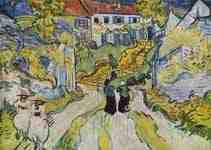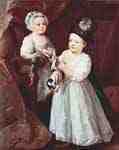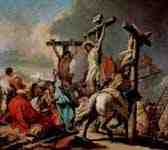City Art Museum, Saint Louis (Missouri)

Portrait of Thaddeus Burr, John Singleton Copley

Street and road in Auvers, Vincent Willem van Gogh

Portrait of Lady Mary Grey and Lord George Grey, William Hogarth

Crucifixion, Giovanni Battista Tiepolo
----
Fine Art Prints | Greeting Cards | Phone Cases | Lifestyle | Face Masks | Men's , Women' Apparel | Home Decor | jigsaw puzzles | Notebooks | Tapestries | ...
----
The Saint Louis Art Museum is one of the principal U.S. art museums, with paintings, sculptures, cultural objects, and ancient masterpieces from all corners of the world. Its three-story building stands in Forest Park in St. Louis, Missouri, where it is visited by up to a half million people every year. Admission is free through a subsidy from the cultural tax district for St. Louis City and County.[1]
In addition to the featured exhibitions, the museum offers rotating exhibitions and installations. These include the Currents series, which features contemporary artists, as well as regular exhibitions of new media art and works on paper.[2]
History
The museum was founded in 1881 as the Saint Louis School and Museum of Fine Arts, an independent entity within Washington University in St. Louis, housed in a downtown building.[3] The building was originally built by Wayman Crow as a memorial to honor his son, Wayman Crow Jr. Crow employed Boston architects Peabody & Stearns to design the building located at 19th and Lucas Place (now Locust Street). The school, led by directory Halsey C. Ives, educated two generations of St. Louis artists and craftspeople and offered studio and art history classes supported by a museum collection. After the school moved to Washington University's campus and the museum moved to Forest Park, the building fell into disrepair and was eventually demolished in 1919.[4]
The museum moved after the 1904 World's Fair, also known as the Louisiana Purchase Exposition, to the Palace of Fine Arts, built for the fair from 1902 to 1903. The building was designed by architect Cass Gilbert, who took inspiration from the Baths of Caracalla in Rome, Italy.[5] The Mildred Lane Kemper Art Museum remained part of Washington University, and the collection was lent to the Saint Louis Art Museum for several years.[6]
In 1908, the museum's first director, Halsey Cooley Ives, arranged for a municipal tax to support the museum.[7] The following year, the museum separated from Washington University and was renamed the City Art Museum. An organizing board was assigned to take control in 1912.[8]
During the 1950s, the museum added an extension to include an auditorium for films, concerts and lectures.
In 1971, efforts to secure the museum's financial future led voters in St. Louis City and County to approve the creation of the Metropolitan Zoological Park and Museum District (ZMD). This expanded the tax base for the 1908 tax to include St. Louis County.[9] In 1972, the museum was again renamed, to the Saint Louis Art Museum.[9]
Today, the museum is supported financially by the tax, donations from individuals and public associations, sales in the Museum Shop, and foundation support.[10]
Expansion
Plans to expand the museum, which existed in the 1995 Forest Park Master Plan and the museum's 2000 Strategic Plan, began in earnest in 2005, when the museum board selected the British architect Sir David Chipperfield to design the expansion; Michel Desvigne was selected as landscape architect. The St. Louis-based firm, Hellmuth, Obata, and Kassabaum (HOK) was the architect of record to work with the construction team.
On November 5, 2007, museum officials released the design plans to the public and hosted public conversations about those plans. A model of the new building was displayed in the museum's Sculpture Hall throughout the construction project. In 2008, citing the declining state of the economy, the museum announced that it would delay the start of the expansion, whose cost was then estimated at $125 million.[11]
Construction began in 2009; the museum remained open.[12][13] The expansion added more than 224,000 square feet (20,800 m2) of gallery space, including an underground garage, within the lease lines of the property. Money for the project was raised through private gifts to the capital campaign from individuals, foundations and corporations, and from proceeds from the sale of tax-exempt bonds. The fundraising campaigned covered the $130-million cost of construction and a $31.2 million increase to the museum's endowment to support incremental costs of operating the larger facility. The expanded facility opened in the summer of 2013.
Collection
The collection of the Saint Louis Art Museum contains more than 30,000 art works dating from antiquity to the present. The collection is divided into eleven areas:
African
American
Ancient and Islamic
Asian
Contemporary
Decorative Arts and Design
European
Modern
Oceanic
Mesoamerican and American Indian
Prints, Drawings, and Photographs
The modern art collection includes works by the European masters Matisse, Gauguin, Monet, Picasso, Giambattista Pittoni and Van Gogh. The museum's particularly strong collection of 20th-century German paintings includes the world's largest Max Beckmann collection, which includes Christ and the Woman Taken in Adultery. In recent years, the museum has been actively acquiring post-war German art to complement its Beckmanns, such as works by Joseph Beuys, Gerhard Richter, Martin Kippenberger and others.[12] The collection also includes Chuck Close's Keith (1970).[14]
The collections of Oceanic and Mesoamerican works, as well as handwoven Turkish rugs, are among the finest in the world. The museum holds the Egyptian mummy Amen-Nestawy-Nakht, and two mummies on loan from Washington University.[15] Its collection of American artists includes the largest U.S.-museum collection of paintings by George Caleb Bingham.
The collection contains at least six pieces that Nazis confiscated from their own museums as degenerate.[16] These include Max Beckmann’s “Christ and the Woman Taken in Adultery” which came to the museum through a New York art dealer, Curt Valentin, who specialized in Nazi confiscations, and Matisse's “Bathers with a Turtle” which Joseph Pulitzer purchased at the Galerie Fischer auction held in the Grand Hôtel National, Lucerne, Switzerland, June 30, 1939.[16][17][18]
In the context of the museum's 2013 expansion, British artist Andy Goldsworthy created Stone Sea, a site-specific work for a narrow space between the old and new buildings. Twenty-five tightly packed, ten-foot-high arches made of native limestone rise in a sunken courtyard. The artist was inspired by the fact that the sedimentary rock was formed when the region was a shallow sea in Prehistoric times.[12]
Bartolomeo Manfredi, Apollo and Marsyas, 1616–20
Rembrandt van Rijn, etching The Windmill, 1641
George Caleb Bingham, The Verdict of the People, 1854–55
Vincent van Gogh. Stairway at Auvers, 1890
Robert Henri Portrait of Carl Gustav Waldeck, 1896
Portrait of a young woman, formerly attributed to Jean Etienne Liotard (18th century)
Services
Art classes for children, adults, and teachers. Each costs about $10–$200.
Richardson Memorial Library, one of the largest centers for the history and documentation of art in the Midwest, holding more than 100,000 volumes and the museum's archives. Both can be searched through their online catalog.[2][19]
Resource Center, a loan collection of educational materials circulated through the museum's nine satellite resource centers in Missouri.[2]
Free guided tours for groups led by trained docents.[2]
References
Saint Louis Art Museum Visitor Guide (2007)
Saint Louis Art Museum Web Site
Saint Louis Art Museum Handbook of the Collection (2004), p. 8
St. Louis Public Library. "The St. Louis School and Museum of Fine Arts – Wellspring of St. Louis Arts". St. Louis Public Library. Retrieved September 30, 2016.
Saint Louis Art Museum, An Architectural History (1987), p. 8
"About the collection | Kemper Art Museum". kemperartmuseum.wustl.edu. Retrieved 2015-12-11.
Stevens, Walter B. Page 30
Saint Louis Art Museum Handbook of the Collection (2004), p. 10
Saint Louis Art Museum, An Architectural History, (1987), Page 26
Saint Louis Art Museum Handbook of the Collection (2004), pp. 4–16
David Itzkoff ( November 6, 2008), In Tough Times, St. Louis Museum Delays Expansion New York Times.
Javier Pes (June 20, 2013), A ‘quiet and reserved’ new wing for Saint Louis Art Museum Archived 2013-06-30 at the Wayback Machine. The Art Newspaper.
"Saint Louis Art Museum: Expansion". Slam.org. Retrieved 2012-10-14.
Saint Louis Art Museum, Handbook of the Collection (2004), p. 299
Washington University of Saint Louis, Student Life, 2006
Hunn,David. "How a French masterpiece stolen by Nazis came to St. Louis" [1] St. Louis Post-Dispatch, February 22, 2014
Stein,Laurie."The History and Reception of Matisse's Bathers with Turtle in Germany, 1908-1939" St. Louis: The Saint Louis Art Museum, 1998
http://slam.org:8080/emuseum/view/objects/asitem/2492/271/title-desc?t:state:flow=05f6beb5-fe7f-488b-9b22-8dbe095bf295
"Richardson Library Books & Periodicals". Slrlc.org. Retrieved 2012-10-14.
More information
Saint Louis Art Museum 2004, Saint Louis Art Museum Handbook of the Collection, Saint Louis Art Museum, Saint Louis, Mo.
Saint Louis Art Museum 1987, Saint Louis Art Museum, An Architectural History, Fall Bulletin, Saint Louis Art Museum, Saint Louis, MO.
Stevens, Walter B. (ed.) 1915, Halsey Cooley Ives, LL.D. 1847–1911; Founder of the St. Louis School of Fine Arts; First Director of the City Art Museum of St. Louis, Ives Memorial Society, Saint Louis, MO
Visitor Guide (brochure), Saint Louis Museum of Art, 2005.
Washington University of Saint Louis, Student Life, 2006, Buried Treasure:University Owned Mummy Kept at Saint Louis Museum.
Artist
A - B - C - D - E - F - G - H - I - J - K - L - M -
N - O - P - Q - R - S - T - U - V - W - X - Y - Z
Retrieved from "http://en.wikipedia.org/"
All text is available under the terms of the GNU Free Documentation License


